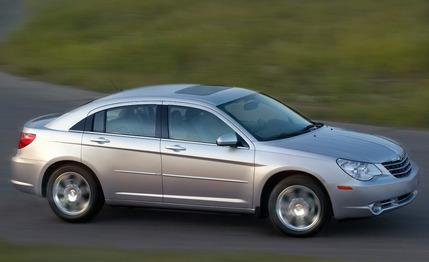 Review
Review
Introduction
The Chrysler Sebring name is placed on both a four-door family sedan and a two-door convertible. Both versions of the Sebring are built using the same front-wheel-drive platform that underpins the Dodge Avenger. The Sebring sedan was completely redesigned for 2007; the convertible emerged all-new in 2008. Both body styles soldier into 2009 with few changes, the most notable of which is the deletion of an all-wheel-drive option for the sedan.
Three engines are available in the Sebring. The standard powertrain is a 2.4-liter four-cylinder engine with 173 horsepower mated to a four-speed automatic. The four-cylinder lacks the muscle to move the Sebring with any sort of authority, but it does return a respectable 21 mpg in the city and 30 mpg on the highway. Stepping up to the 2.7-liter V-6 yields 186 horsepower and the ability to run on E85 (fuel comprised of 85-percent ethanol and 15-percent gasoline). The 2.7-liter comes with a four-speed automatic and even though it doesn’t have much more horsepower than the four-cylinder, the V-6 is far quieter and smoother than the smaller four-cylinder engine.
As one would expect of a larger engine, the 2.7-liter V-6 cannot match the fuel economy of the four cylinder; the 2.7-liter should return 19 mpg in the city and 27 mpg on the highway. For customers seeking more performance, Chrysler offers a 3.5-liter V-6 with 235 horsepower. The big V-6 comes standard with a six-speed automatic and provides strong acceleration but urban fuel economy suffers, as it manages only 16 mpg in the city. A more respectable 27 mpg is achieved on the highway.
The Sebring convertible is unique among convertibles as it gives buyers the choice between a retractable hardtop and a conventional soft top. The retractable hardtop, available on Touring and Limited models, commands a roughly $2000 premium over the soft top, but the metal roof is quieter and gives the Sebring a more finished appearance. Both of the Sebring convertible’s tops are power operated and easy to use.
Compared to its rivals, the Sebring sedan fails to impress. In a comparison test conducted when it was freshly redesigned, the Sebring sedan finished in last place behind the Toyota Camry, Saturn Aura, Kia Optima, Nissan Altima, and Honda Accord. Equipped with the base four-cylinder engine (only the Aura boasted V-6 power), the Sebring was criticized for lacking power and refinement. A soft suspension and soggy controls and responses gave the Sebring a senior-citizen feel, and we wrote that “everyone who climbed aboard the Sebring felt it was aimed at buyers for whom Buicks have become too racy.” The styling drew its share of criticism as well; one tester found the interior particularly offensive and thought it looked “constructed from the parts of five different cars to look like the lobby of the Chrysler Building.” Interior space was tighter than rivals and was judged to be the least comfortable.
The Sebring convertible didn’t fare much better than the sedan in its own comparison test. Pitted against the Pontiac G6 and Ford Mustang convertibles, the Sebring’s lazy responses, slow acceleration, and appliance-like nature landed it in last place. The Sebring convertible did draw compliments for its excellent trunk space and quiet interior.
For 2009, the Sebring comes in three different trim levels (LX, Touring, and Limited). All Sebring sedans come standard with the 2.4-liter four-cylinder engine, while Touring models offer an optional 2.7-liter V-6, and Limited models offer both the 2.7-liter and the more powerful 3.5-liter V-6. The convertible is a bit different, as LX convertibles come with the four-cylinder engine, the Touring gets the 2.7-liter V-6 standard, and the Limited comes standard with the 3.5-liter V-6.
Verdict
The latest Sebring has, um, “unique” styling that may not appeal to some. With the exception of models powered by the 3.5-liter V-6, the Sebring is slow to accelerate. Lazy responses, dull handling, a soft ride, and an unexciting demeanor will send buyers who actually enjoy driving straight into competitors’ showrooms.
Click here to read our full review of the Chrysler Sebring.
Click here to read our latest comparison test involving the Chrysler Sebring.
Click here to read our full review of the Chrysler Sebring convertible.
Click here to read our latest comparison test involving the Chrysler Sebring convertible.
What’s New for 2009
Beyond the deletion of an all-wheel-drive option for Limited sedans—it wasn’t available on any droptop—the Sebring enters 2009 with only a few minor changes: a new shade of gray graces the interior, improved sound deadening, a sunglasses holder, a trunk mat, and four-wheel disc brakes are now standard on all models. Electronic stability control (ESP in Chrysler-speak), an eight-way power driver’s seat, leather-wrapped shifter and steering wheel with audio controls are now standard on Touring and Limited trim levels. Top-dog Limited models get more standard equipment including remote start, heated and cooled cup holders, and a trunk cargo organizer.
Highlights and Recommendations
If at all possible, avoid the 2.4-liter four-cylinder engine. Although the four-cylinder returns respectable fuel economy for a mid-size family sedan, the engine drones excessively and lacks power. Moving up to the 2.7-liter V-6 only adds a bit more power, but the engine is smoother and easier to live with. The powerful 3.5-liter V-6 is likely overkill for most and returns a disappointing 16 mpg in the city cycle.
Unless you can get an out-of-this-world deal, however, our best advice would be to skip the disappointing Sebring altogether and visit almost any other dealership. If you prefer domestic models, the Chevy Malibu and Ford Fusion are leagues better to drive, and nicer to look at, too. Other top picks include the Accord and the freshly redesigned Mazda 6.
Safety
Dual front airbags, front-seat-mounted side-impact airbags, side-curtain side-impact airbags, front seatbelt pretensioners, tire-pressure monitoring, and anti-lock brakes are standard on all Sebring models. Electronic stability control and traction control are standard on Limited and Touring models and unavailable on the LX trim level.